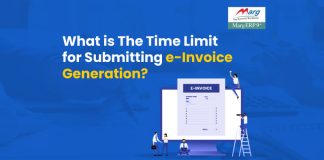Tag: e invoice format
What is the time limit for submitting e invoice generation?
E-invoices must be created within the notified time limit of 30 days from the invoice date. Earlier, the e invoice generation time limit was seven days, but the government postponed the implementation by three months. However, currently, the law applies to only some notified taxpayers. The limitation obliges businesses to adopt Live invoicing.
Before jumping to the time limit of e-invoice, let’s first understand it and its process.
What is e-invoicing?
An e-invoice is a digital document that is exchanged by buyers and suppliers and validated by the Government Tax Portal. E-invoicing is the proposed system where B2B invoices are prepared online in the e invoice format and certified by the GSTN. this system ascertains that the same format is implemented by all businesses before reporting invoices to the e invoice portal login.
In August 2019, the government published a draft of an e-invoice for public view, later, modified by the GST Council to adhere to their regulations. The standard format makes adherence easier and because it’s applied across industries, it ensures interoperability between GST ecosystems.
What is the e invoice time limit?
The time limit to create an e-invoice on the Invoice Registration Portal for all tax invoices and Credit & Debit notes issues is thirty days from the given date in the invoice and debit or credit note. For example, if an invoice’s date is 2nd April 2024, then it must be reported by 1st May 2024 on the IRP.
Who must comply with the e-invoicing time limit?
https://youtu.be/klGtFx636Ww
GSTN defined that all taxpayer organizations with an Annual Aggregate Turnover of Rs. 100 crore or more must abide by the time limit. The thirty-day time limit applies to Reporting Tax Invoices, Credit & Debit notes to any notified IRP, entailing any outdated documents unreported as of 1st April 2023.
However, the validation or rule doesn’t apply to taxpayers with AATO of less than INR 100 crore.
The legal status of the e-invoicing time limit
The latest notification for the e invoice generation time limit, the GST law doesn’t limit any time limit for taxpayers for documents reporting on the e-invoice portals or IRP to generate e-invoice. By default, the GST provision on the supply time and time limit to generate invoices would apply to all taxpayers. Nevertheless, the limitations of 30 days time limit to report documents on IRP are put by the GSTN.
Consequences of not abiding by the e-invoicing time limit
The IRP has internal validation to accept only tax invoices and credit & debit notes within 30 days. Such taxpayers cannot create e-invoices and will be considered non-compliant under the law of GST.
If the team fails to meet the e-invoicing deadline of 30 days, they must re-raise the invoice and report it to IRP. it leads to late reporting or an automatic population of e-invoices in GSTR1.
It influences the input tax credit flow and supply chain because of delay. Consequently, it deteriorates relationships with customers.
The GST legislation enforces a huge penalty in the following manner-
For incorrect invoicing – Rs.25,000 / invoice (for the issued invoice with no IRN and signed QR code).
For non-generation of e-invoice – 100% tax due or Rs.10,000, whichever is higher, for each invoice. (if the invoice is not issued)
What are the major advantages of e-invoice?
The business world after the pandemic is different from how it was pre-pandemic. With a larger adoption of digital techniques, e-invoicing has proven extensively beneficial for everyone involved. Let’s move forward to know the benefits of e-invoicing.
1. Saves time
E-invoicing saves time for businesses which is a key advantage for them. E-invoicing is a digital process that takes only a few minutes. Earlier, traditional invoicing needed so much time to create and upload details of invoices to the government portal for return filing. Whereas, e-invoicing doesn’t require processing, sending, tracking, and approving invoices. Hereby, it has made productivity better as it saves employees time that they can use on other crucial aspects that require more attention. E-invoicing makes the payment process faster and information aggregation is done fluently.
2. Improved accuracy
E-invoice eliminates human errors, resulting in improved accuracy. You don’t have to manually enter the data which minimizes the probability of errors. Additionally, the information is directly fetched from the e-invoices and the billing systems also manage information, which ensures no errors during the e-invoice process. The communication between vendors and buyers will be improved and consequently, processing time will be saved due to no errors in the e-invoices.
3. Cost-effective
E-invoicing is more affordable for businesses as compared to the traditional way of invoicing and reporting. As the whole process is digital, it shortens it automatically. Unlikely the traditional method, you don’t have to spend more energy on e-invoicing.
4. Accessibility
On the contrary heavy folders with tons of paper, digital allow you quick access with a great safety level.
Search Anywhere: With a digital management platform, documents can be easily accessed without a physical search...

